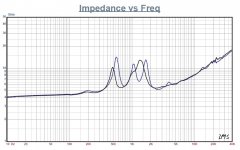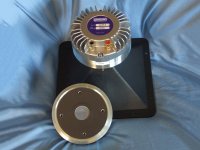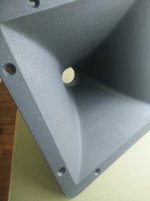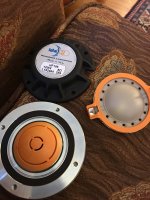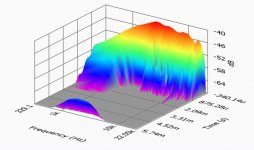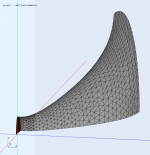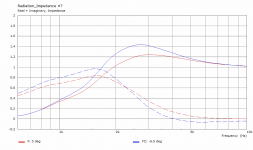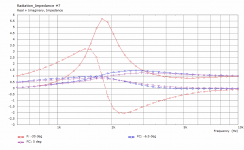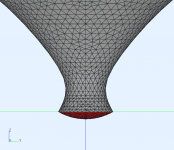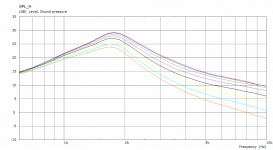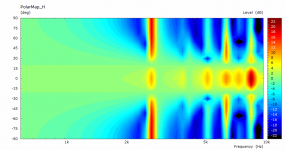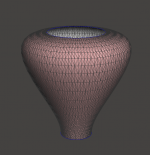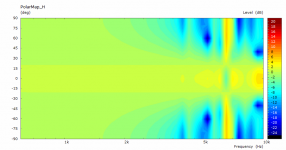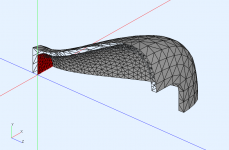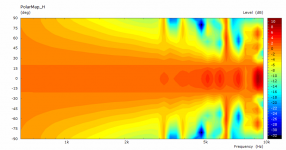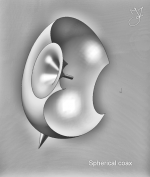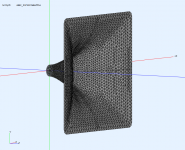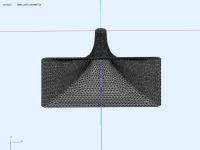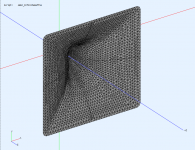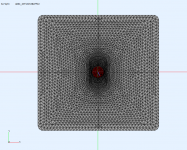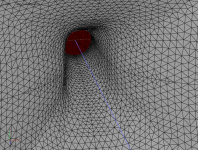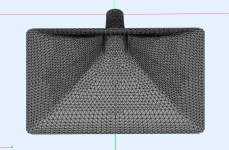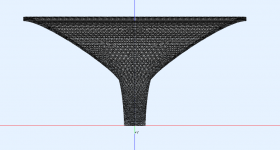According to Vance Dickason:
"The solid black curve represents the Radian 951PB mounted on the B&C ME90 horn and the dashed blue curve represents the compression driver without the horn. With a 5.02 Ω DCR (Re), the minimum impedance of the 951PB/ ME90 was 5.4 Ω and at 2.5 kHz."
"The solid black curve represents the Radian 951PB mounted on the B&C ME90 horn and the dashed blue curve represents the compression driver without the horn. With a 5.02 Ω DCR (Re), the minimum impedance of the 951PB/ ME90 was 5.4 Ω and at 2.5 kHz."
Attachments
4kHz resonance is smoothed because of a horn vs bare driver. Interestingly breakup shift and 200hz - what is this? A leakage?
Last edited:
There's another practical implementation (courtesy of misog) -
(The raw waveguide measured with 4 ms window. I believe the driver is 18Sound NSD1095N and the woofers are 10".)
If this is indeed the NSD1095N, the extension in the top octave is rather disappointing for such an expensive 1" driver.
Even when taking the waveguide into consideration.
In fact, it's worse than some drivers with 2.5 and 3" diaphragms.
OTOH, it's pretty smooth and should sound nice after equalization.
Do we have a list of comp drivers with naked phase plug at throat suitable for ATH waveguides?
What does this have to do with what was discussed before? 😕
Would be interesting to see acoustic impedance though.
Since no one has shared the impedance of the Radian 951 + ATH4 yet, Dickason's plot is all we have😉
Do we have a list of comp drivers with naked phase plug at throat suitable for ATH waveguides?
'We' might start another thread - if possible with a sticky first page that includes the list.
Here's a proper initial candidate.
While the phase plug doesn't quite end at the exit, its 31° angle should suffice.
Attachments
Last edited:
This is what I meant when I said "acoustic impedance". The question was about the influence of a negative throat angle -
These are two ~10" OS waveguides, 36 mm throat. All that is different is the throat angle: 0 and -6.5 degrees:

These are two ~10" OS waveguides, 36 mm throat. All that is different is the throat angle: 0 and -6.5 degrees:
Attachments
Added -30 deg.

Attachments
Last edited:
Added -30 deg.
Can you also post the SPL plot of the -6.5° exit?
I wonder if the small negative angle will be problematic in reality.
Obviously it is not ideal.
But given the plot of the NSD1095N, I don't expect the -6.5° to be much worse.
Last edited:
No I don't think this would be a problem. NSD1095N has quite heavy diaphragm, it seems, so it falls more rapidly and may indeed require more elaborate equalization - that's the drawback.
Last edited:
Indeed. The Nitrogen PVD is quite effective in suppressing breakup, but despite the strong motor, the usable bandwidth appears to be limited not only in the top octave, but also at the low end.
An internal roundover towards a center gap.
The last two should actually work quite well.
The last two should actually work quite well.
Last edited:
Try spherical mouth? Can we compare with custom Minphase horn?
Min Phase Horn with Faital Drivers at German DIY Show in Gelsenkirchen
Min Phase Horn with Faital Drivers at German DIY Show in Gelsenkirchen
Attachments
I have no thoughts on that yet.
- If anyone wanted to study such devices as the one shown below, simply use the guiding curve and the morph feature - it occurrred to me today how easy it is with Ath, with all the niceties of the tool availabe. The initial cross-sectional shape is given by a superformula here and it is morpherd to a rectangle, starting at about half of the length.
- If anyone wanted to study such devices as the one shown below, simply use the guiding curve and the morph feature - it occurrred to me today how easy it is with Ath, with all the niceties of the tool availabe. The initial cross-sectional shape is given by a superformula here and it is morpherd to a rectangle, starting at about half of the length.
Attachments
Last edited:
How abrupt the transition will be can be controlled by "Morph.StretchExp", as usual (the lower the value the more abrupt, creating more of a diffraction device).
Attachments
Last edited:
- Home
- Loudspeakers
- Multi-Way
- Acoustic Horn Design – The Easy Way (Ath4)
